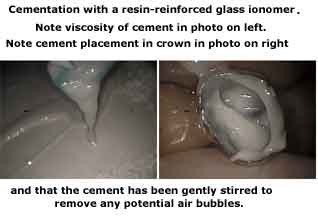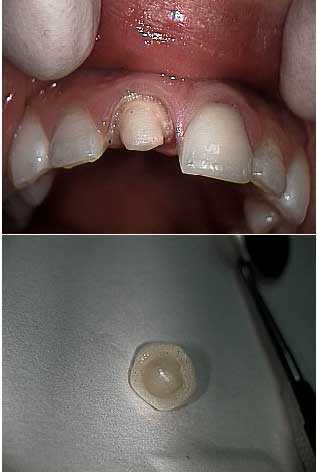Before and after photos on dental cements luting agents and glue for crowns performed in our General Dentistry office.

Tooth #8 fractured and a cast gold post and core was placed with dental cement. Consider mixing vaseline with temporary cement under the temporary crown to minimize retention. This will reduce the dislodging force on the post when removing the temporary crown. Pumice the post before final crown cementation.

Dental cement placement technique for a porcelain fused to metal (pfm) crown (cap). How to mix dental glue for tooth cap placement. Dental luting agent photo. Note: the last word in the sentence reads “…bubbles.”

Dental Cement placement technique for a pfm three teeth bridge. How to pictures. Dental luting. Note: the last words in the sentence read “…the crown during seating.”

Tooth abutment preparation prior to placement of dental cement glue.

An upper anterior porcelain dental crown cement failure is shown. 1) Obvious tooth decay. 2) The failed crown with the prefabricated post still in it. 3) and 4) Tooth preparation to determine the necessity for crown lengthening.

An anterior porcelain crown had come out. It is better to rebond this with resin cement than to just use traditional dental cement.

Telescopic Dental Copings pictures.
They should be placed over abutment teeth if these teeth will be joined to dental implants within the same prosthesis. The coping is cemented with permanent dental cement to the abutment teeth. The dental prosthesis may then be cemented over it with a temporary dental cement. This allows a fixed-removable dental prosthesis without the possibility of recurrent decay.
They should be placed over abutment teeth if these teeth will be joined to dental implants within the same prosthesis. The coping is cemented with permanent dental cement to the abutment teeth. The dental prosthesis may then be cemented over it with a temporary dental cement. This allows a fixed-removable dental prosthesis without the possibility of recurrent decay.

Dental cement “wash out” – leakage – under an old three teeth bridge.

Emergency Crown (#9) Out. Dental luting agent failure. Crown appears to have been cemented with lots of excess dental cement with the hope of providing retention. It won’t work. The crown margin appears to end on the post/core, not solid tooth structure. This also won’t work.
The high lipline prevents crown lengthening perio surgery. The patient was informed that extraction, then implant or fixed bridge was ideal treatment. The cap was recemented at her request after being informed that it could easily come out and be swallowed.
The high lipline prevents crown lengthening perio surgery. The patient was informed that extraction, then implant or fixed bridge was ideal treatment. The cap was recemented at her request after being informed that it could easily come out and be swallowed.

ALWAYS check dental cement seals of fixed teeth bridgework during exams. Over time this glue can weaken in saliva and a dental bridge can loosen. The tiny space where the cement was can now allow bacteria in that can cause tooth decay inside the dental crown. This can be nearly impossible to see clinically or on an x-ray until the cavity is quite large. A thorough examination of each patient is the only way to discover this problem early and treat it before extensive tooth damage results.

Dental cement leakage – failure -under an old three teeth bridge. Over time this glue can weaken in saliva and a dental bridge can loosen. The tiny space where the cement was can now allow bacteria in that can cause tooth decay inside the dental crown. This can be nearly impossible to see clinically or on an x-ray until the cavity is quite large. A thorough examination of each patient is the only way to discover this problem early and treat it before extensive tooth damage results.

Surgical exposure of a palatally impacted upper canine and placement of an orthodontic bracket using dental cement and elastic power chain. 1) Panorex showing the horizontal impaction of the upper right canine. 2) Initial exposure of the impacted canine and extraction site after removal of an over-retained deciduous tooth. 3) Orthodontic bracket cemented to the canine. 4) Elastic orthodontic power chain attached to the bracket. 5) Emergence of power chain through the extraction site after suturing. The power chain will be attached to the arch wire to exert a pulling force on the canine to bring it into the area of the present extraction site. The canine will assume a normal position in the arch in 18-24 months.